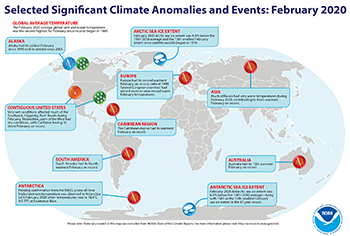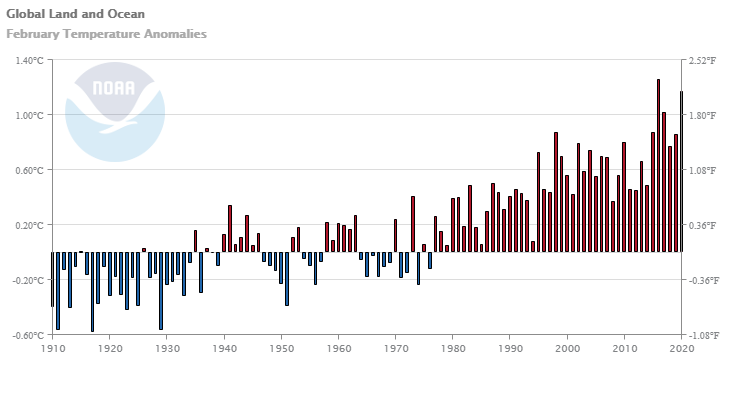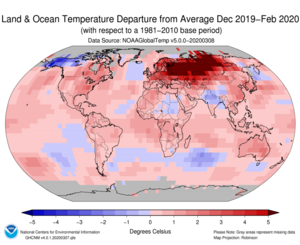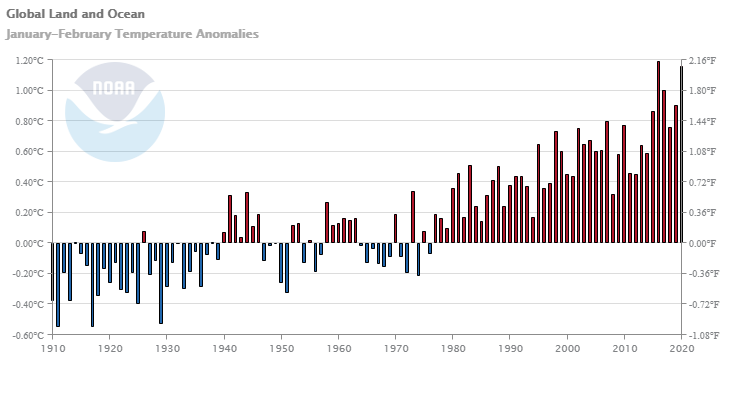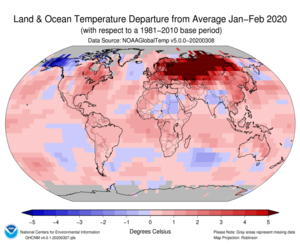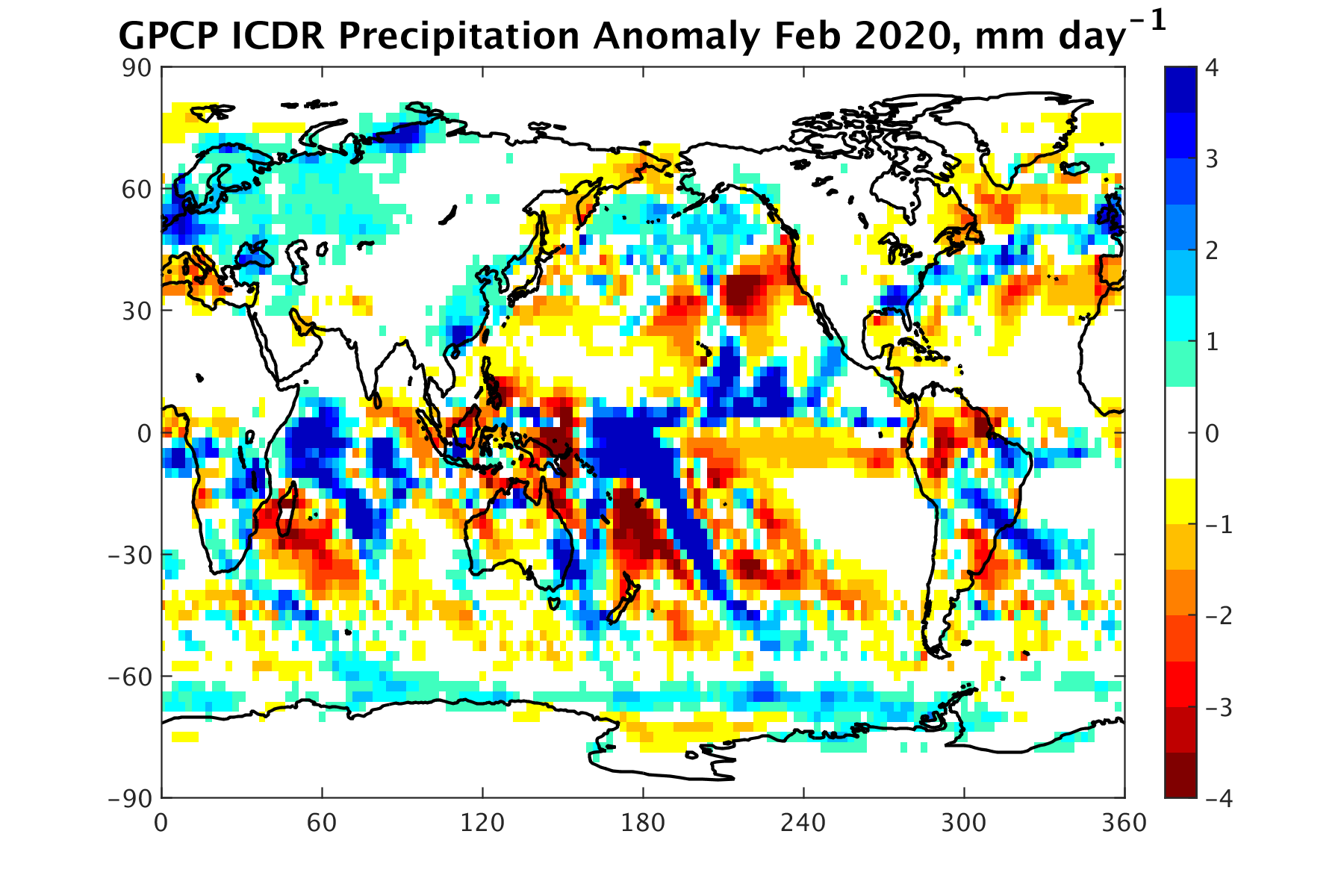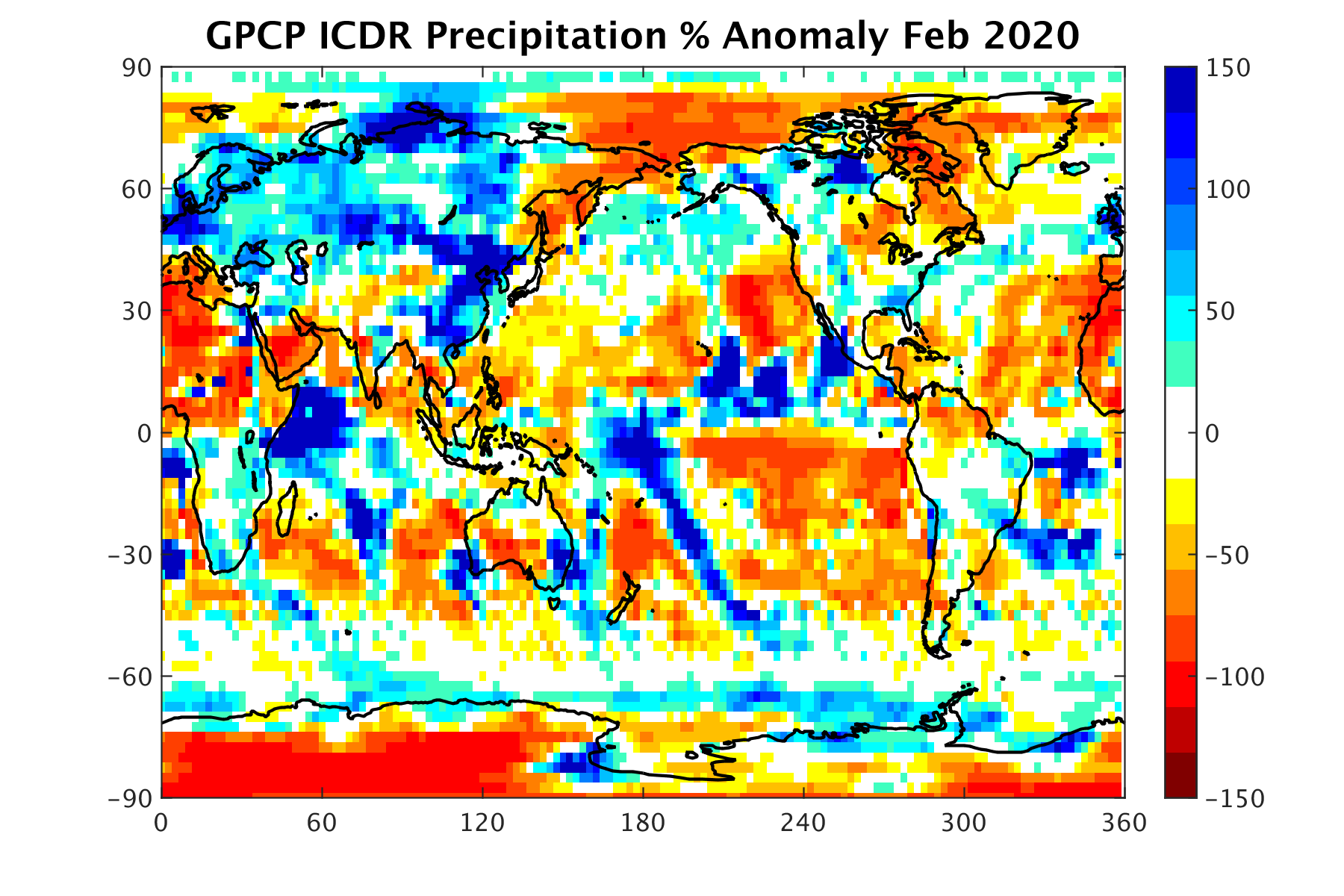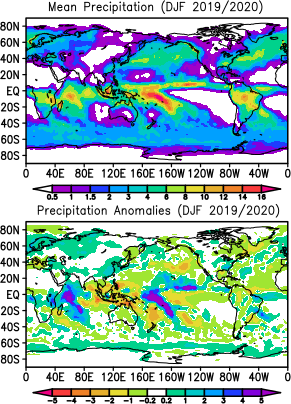Introduction
Temperature anomalies and percentiles are shown on the gridded maps below. The anomaly map on the left is a product of a merged land surface temperature (Global Historical Climatology Network, GHCN) and sea surface temperature (ERSST version 5) anomaly analysis. Temperature anomalies for land and ocean are analyzed separately and then merged to form the global analysis. For more information, please visit NCEI's Global Surface Temperature Anomalies page. The percentile map on the right provides additional information by placing the temperature anomaly observed for a specific place and time period into historical perspective, showing how the most current month, season or year compares with the past.
Temperature
Monthly Temperature: February 2020
The month was characterized by warmer-than-average conditions across much of the land and ocean surfaces, with the most notable warm temperatures across much of Europe and western and central Asia where temperature departures were at least 4.0°C (7.2°F) above average or higher. Meanwhile, Alaska, northern Canada, and Far East Russia had the most notable cool temperature departures at 3.0°C (5.4°F) below average or cooler. Much of this warmth across the mid-latitude and cool temperatures across Alaska and Polar Regions can be attributed to the positive phase of the Arctic Oscillation (AO). During a positive AO, very strong winds circulate in the jet stream which trap very cold air at the poles, while the mid-latitudes tend to have warmer-than-average temperatures. During February 2020, the daily AO index was very high, setting a new all-time record high value on 21 February 2020 at 6.07. Please see our Synoptic Discussion page for additional information.
Although unusually warm temperatures engulfed much of Russia and Europe during February 2020, only a few locations had record warm February temperatures. Other record warm temperatures were present across parts of the Atlantic, Indian, and western Pacific oceans.
Averaged as a whole, February 2020 was near-record warm with a global land and ocean surface temperature departure from average of 1.17°C (2.11°F) above the 20th century average. Only February 2016 was warmer. This month marked the 44th consecutive February and the 422nd consecutive month with temperatures, at least nominally, above the 21th century average. The 10 warmest Februarys have occurred since 1998. The February 2020 temperature departure from average was also the third highest monthly temperature departure from average for any month in the 1,682-month record. Only March 2016 (+1.31°C / +2.36°F) and February 2016 (+1.26°C / +2.27°F) had a higher temperature departure.
According to NOAA's Climate Prediction Center (CPC), ENSO-neutral conditions were present across the tropical Pacific Ocean during February 2020. This means that the February 2020 global land and ocean surface temperature departure from average was the highest monthly temperature departure without an El Niño present in the tropical Pacific Ocean, surpassing the previous record set only last month (January 2020). The months of February and March 2017, December 2019, and January 2020 were the other months with temperature departures above 1.0°C (1.8°F) during ENSO-neutral conditions. CPC states that ENSO-neutral is favored during the Northern Hemisphere winter (Southern Hemisphere summer). This forecast focuses on the ocean surface temperatures between 5°N and 5°S latitude and 170°W to 120°W longitude, called the Niño 3.4 region.
The global land-only and global ocean-only temperatures were also the second highest on record, trailing behind February 2016. The February 2020 global land-only temperature departure of 2.27°C (4.09°F) was also the third highest for any month in the 1,682-month record. Only March 2016 (+2.52°C / +4.54°F) and February 2016 (+2.42°C / +4.36°F) were warmer.
The Northern Hemisphere global land and ocean surface temperature was also second warmest on record at 1.58°C (2.84°F) above the 20th century average. This value is only 0.07°C (0.13°F) shy of tying the record-warm February set in 2016. Meanwhile, the Southern Hemisphere land and ocean surface temperature departure of +0.76°C (+1.37°F) tied with 2017 and 2019 as the second warmest February in the 141-year record.
Regionally, Asia and the Caribbean region had their warmest February on record with temperatures at 4.09°C (7.36°F) and 1.09°C (1.96°F) above average, respectively. For the Caribbean region, this was the first time a February temperature was above 1.0°C (1.8°F) and tied with September 2005 as the ninth highest monthly temperature departure for any month in the 1,322-month record for the region. Asia had its second warmest monthly temperature departure on record, behind March 2008, and marked only the second time monthly temperature departures were above 4.0°C (7.2°F) on record.
February 2020 was Europe's second warmest February and the second warmest monthly temperature for any month on record with a temperature departure from average of 3.86°C (6.95°F), which is only 0.25°C (0.45°F) shy of tying the record warm February of 1990.
| February | Anomaly | Rank (out of 141 years) | Records | ||||
|---|---|---|---|---|---|---|---|
| °C | °F | Year(s) | °C | °F | |||
| Global | |||||||
| Land | +2.27 ± 0.11 | +4.09 ± 0.20 | Warmest | 2nd | 2016 | +2.42 | +4.36 |
| Coolest | 140th | 1893 | -1.69 | -3.04 | |||
| Ocean | +0.76 ± 0.14 | +1.37 ± 0.25 | Warmest | 2nd | 2016 | +0.83 | +1.49 |
| Coolest | 140th | 1904 | -0.54 | -0.97 | |||
| Land and Ocean | +1.17 ± 0.14 | +2.11 ± 0.25 | Warmest | 2nd | 2016 | +1.26 | +2.27 |
| Coolest | 140th | 1893, 1905 | -0.63 | -1.13 | |||
| Northern Hemisphere | |||||||
| Land | +2.72 ± 0.11 | +4.90 ± 0.20 | Warmest | 2nd | 2016 | +2.79 | +5.02 |
| Coolest | 140th | 1893 | -1.97 | -3.55 | |||
| Ocean | +0.88 ± 0.14 | +1.58 ± 0.25 | Warmest | 2nd | 2016 | +0.94 | +1.69 |
| Coolest | 140th | 1904 | -0.60 | -1.08 | |||
| Land and Ocean | +1.58 ± 0.13 | +2.84 ± 0.23 | Warmest | 2nd | 2016 | +1.65 | +2.97 |
| Coolest | 140th | 1893 | -1.01 | -1.82 | |||
| Southern Hemisphere | |||||||
| Land | +1.13 ± 0.11 | +2.03 ± 0.20 | Warmest | 5th | 2016 | +1.50 | +2.70 |
| Coolest | 137th | 1917 | -1.04 | -1.87 | |||
| Ocean | +0.69 ± 0.14 | +1.24 ± 0.25 | Warmest | 3rd | 2016 | +0.76 | +1.37 |
| Coolest | 139th | 1911 | -0.52 | -0.94 | |||
| Land and Ocean | +0.76 ± 0.14 | +1.37 ± 0.25 | Warmest | 2nd | 2016 | +0.88 | +1.58 |
| Coolest | 140th | 1917 | -0.61 | -1.10 | |||
| Ties: 2017, 2019 | |||||||
| Arctic | |||||||
| Land and Ocean | +2.49 ± 0.78 | +4.48 ± 1.40 | Warmest | 10th | 2016 | +3.51 | +6.32 |
| Coolest | 132nd | 1979 | -3.46 | -6.23 | |||
The most current data can be accessed via the Global Surface Temperature Anomalies page.
Select national information is highlighted below. Please note that different countries report anomalies with respect to different base periods. The information provided here is based directly upon these data:
- Spain's February 2020 temperature of 11.5°C (52.7°F) was 3.0°C (5.4°F) above average, tying with February 1990 as the warmest February since national records began in 1965. The national maximum temperature for February was 4.0°C (7.2°F) above average and the highest February temperature on record. This value surpassed the previous record set in 1990 by 0.5°C (0.9°F). According to Spain's AEMET, 35 stations across Spain had a mean February temperature that was the highest for the month on record.
- According to Météo France, several locations across southern France set new record warm maximum temperatures during February as temperatures soared above 20.0°C (68.0°F). Of note, a maximum temperature of 25.1°C (77.2°F) was observed on 24 February 2020 at Nimes-Courbessac, setting a new monthly maximum temperature record for February for this location. This value exceeds the previous record of 24.6°C (76.3°F) set on 28 February 2019. Temperature records extend back to 1922 for this location.
- Austria's February 2020 national temperature was 4.1°C (7.4°F) above average and tied with 2002 as the second warmest February in the nation's 253-year record. February 1966 is the record warm February with a national temperature departure of +4.5°C (8.1°F).
- February 2020 was Hong Kong's sixth warmest February on record, with a mean temperature that was 2.5°C (4.5°F) above average.
- Australia's February 2020 national temperature was 0.97°C (1.75°F) above the 1961–90 average—the 10th warmest February in the nation's 111-year temperature record. The high mean temperature value for Australia was mainly driven by very warm minimum (nighttime) temperatures. The February national minimum temperature departure from average of +1.21°C (+2.18°F) was the highest since 2007 and the fifth highest since national temperature records began in 1910. Regionally, Queensland, Western Australia, and the Northern Territory had a top four warm minimum February temperature on record.
- According to Argentina's National Weather Service and pending confirmation from the WMO, a new all-time high maximum temperature was recorded in Antarctica when temperatures rose to 18.4°C (65.1°F) at Esperanza Base on 6 February 2020. This temperature surpassed the previous record of 17.5°C (63.5°F) set on 24 March 2015. Records began in 1961 for this location. The Marambio Base set a new temperature record for February when temperatures soared to 15.8°C (60.4°F) on 6 February 2020, surpassing the previous record of 13.8°C (56.8°F) set on 24 February 2013. The all-time high maximum temperature observed in the Marambio Base is 17.4°C (63.3°F) set on 23 March 2015.
- New Zealand had its 11th warmest February on record with a temperature that was 1.0°C (1.8°F) above the 1981–2010 average. Records extend back to 1909 for New Zealand. Several locations across the nation had a record or near-record warm February on record.
Seasonal Temperature: December–February 2020
The December–February period is defined as the Northern Hemisphere's meteorological winter and the Southern Hemisphere's meteorological summer.
The second warmest December, warmest January, and second warmest February gave way to the second warmest December–February seasonal period in the 141-year record. The global land and ocean surface temperature for the three-month season was 1.12°C (2.02°F) above the 20th century average. The three-month period of December 2015–February 2016 had a higher temperature departure at 1.18°C (2.12°F). This value also tied with the three-month period of March–May 2016 as the fourth highest three-month period of any three-month period on record. Only January–March 2016 (tied warmest), February–April 2016 (tied warmest), and December 2015–February 2016 (third warmest) were warmer.
The global land-only surface temperature was the highest on record for December–February at 2.04°C (3.67°F) above the 20th century average. This value was only 0.01°C (0.02°F) warmer than the now second warmest such period set in 2016. The seasonal three-month land-only surface temperature departure was also the third highest three-month global land temperature departure for any three-month period on record, trailing behind February–April 2016 (+2.30°C / +4.14°F) and January–March 2016 (+2.21°C / +3.98°F).
The global ocean-only surface temperature was 0.78°C (1.40°F) above the 20th century average and the second warmest December–February on record. Only December 2015–February 2016 was warmer.
Similar to February 2020, much of the global land and ocean surfaces had warmer-than-average conditions during the three-month period of December 2019–February 2020. The most notable warm temperatures were present across much of Europe and western and central Russia, where temperatures were at least 4.0°C (7.2°F) above average or higher. The most notable cool temperatures were present across much of Alaska and northwestern Canada, where temperatures were at least 3.0°C (5.4°F) below average or cooler. Record-warm December–February temperatures were observed across much of the western half of Russia and parts of Europe, eastern Asia, northern Australia, and across the Atlantic, Indian, and western Pacific oceans. However, no land or ocean areas had record-cold December–February temperatures.
The Northern Hemisphere and Southern Hemisphere had their second warmest December–February period on record. For both hemispheres, only December 2015‐February 2016 was warmer. The Northern Hemisphere had its warmest land-only surface winter temperature on record, with a temperature departure from average of +2.04°C (+3.67°F).
Regionally, December 2019–February 2020 was record warm for Europe and Asia, surpassing their previous record set in 2016 and 2007, respectively, by a wide margin (over 0.70°C / 1.26°F difference). Europe and Asia's temperature departures of +3.29°C (+5.92°F) and +3.22°C (+5.80°F), respectively, marked the first time Europe and Asia's winter temperature exceeded 3.0°C (5.4°F) since regional records began in 1910.
Meanwhile, South America and Oceania had a near-record warm December–February, falling behind 2016 and 2019, respectively.
Select national information is highlighted below. Please note that different countries report anomalies with respect to different base periods. The information provided here is based directly upon these data:
- The Netherlands had their second warmest winter since national records began in 1901. The December 2019–February 2020 national temperature of 6.4°C (43.5°F) was 3.0°C (5.4°F) warmer than average. This value is only 0.2°C (0.4°F) shy of tying the record warm winter of 2006–2007.
- Winter 2019–20 was France's warmest winter since national records began in 1900, with a temperature departure from average of 2.7°C (4.9°F) above the 1981–2010 average. Winter 2015–16 is now the second warmest winter on record at 2.6°C (4.7°F) above average.
- Austria's winter temperature was 2.7°C (4.9°F) above the 1981–2010 average, resulting in the second highest winter temperature since Austria's national temperature records began in 1767. Winter of 2006–07 was warmer with a temperature departure of +3.4°C (+6.1°F).
- Winter 2019–20 was the second warmest for Hong Kong, with a mean temperature of 18.7°C (65.7°F). The nation's minimum temperature was also the second warmest on record, while the nation's maximum temperature of 21.5°C (70.7°F) was the highest on record for Hong Kong.
- Australia had its second warmest summer on record, with a temperature departure from average of +1.88°C (+3.38°F). This is 0.26°C (0.47°F) cooler than the record warm summer of 2018–19. Regionally, Queensland, Western Australia, and the Northern Territory also had their second warmest summer on record. The national maximum and minimum temperatures were also near-record warm at +2.11°C (+3.80°F) and +1.64°C (+2.95°F), respectively. Only the summer of 2018–19 had higher maximum and minimum temperature for the nation. Regionally, Western Australia had the highest summer minimum temperature departure on record at +1.38°C (+2.48°F), surpassing the previous record set in 1972–73 and 2009–10, by 0.43°C (0.77°F). Queensland and the Northern Territory had their second highest maximum and minimum temperatures in the 111-year temperature record.
| December–February | Anomaly | Rank (out of 141 years) | Records | ||||
|---|---|---|---|---|---|---|---|
| °C | °F | Year(s) | °C | °F | |||
| Global | |||||||
| Land | +2.04 ± 0.16 | +3.67 ± 0.29 | Warmest | 1st | 2020 | +2.04 | +3.67 |
| Coolest | 141st | 1893 | -1.48 | -2.66 | |||
| Ocean | +0.78 ± 0.16 | +1.40 ± 0.29 | Warmest | 2nd | 2016 | +0.87 | +1.57 |
| Coolest | 140th | 1904, 1911 | -0.48 | -0.86 | |||
| Land and Ocean | +1.12 ± 0.16 | +2.02 ± 0.29 | Warmest | 2nd | 2016 | +1.18 | +2.12 |
| Coolest | 140th | 1893 | -0.60 | -1.08 | |||
| Northern Hemisphere | |||||||
| Land | +2.33 ± 0.19 | +4.19 ± 0.34 | Warmest | 1st | 2020 | +2.33 | +4.19 |
| Coolest | 141st | 1893 | -1.79 | -3.22 | |||
| Ocean | +0.91 ± 0.15 | +1.64 ± 0.27 | Warmest | 2nd | 2016 | +1.02 | +1.84 |
| Coolest | 140th | 1904 | -0.51 | -0.92 | |||
| Land and Ocean | +1.45 ± 0.16 | +2.61 ± 0.29 | Warmest | 2nd | 2016 | +1.50 | +2.70 |
| Coolest | 140th | 1893 | -1.00 | -1.80 | |||
| Southern Hemisphere | |||||||
| Land | +1.31 ± 0.13 | +2.36 ± 0.23 | Warmest | 3rd | 2016 | +1.40 | +2.52 |
| Coolest | 139th | 1904, 1917 | -0.78 | -1.40 | |||
| Ocean | +0.70 ± 0.16 | +1.26 ± 0.29 | Warmest | 2nd | 2016 | +0.76 | +1.37 |
| Coolest | 140th | 1911 | -0.50 | -0.90 | |||
| Land and Ocean | +0.79 ± 0.15 | +1.42 ± 0.27 | Warmest | 2nd | 2016 | +0.86 | +1.55 |
| Coolest | 140th | 1917 | -0.54 | -0.97 | |||
| Arctic | |||||||
| Land and Ocean | +2.34 ± 0.42 | +4.21 ± 0.76 | Warmest | 3rd | 2016 | +3.07 | +5.53 |
| Coolest | 139th | 1966 | -2.26 | -4.07 | |||
Year-to-date Temperature: January–February 2020
January–February 2020 had a global land and ocean surface temperature that was 1.16°C (2.09°F) above the 20th century average and the second highest such period in the 141-year record. Only January–February of 2016 was warmer by 0.03°C (0.05°F).
The first two months of the year were characterized by warmer-than-average conditions across much of the world's land and ocean surface. However, the most notable warm temperature departures were present across much of western Asia and Europe, where temperatures were at least 3.5°C (6.3°F) above average or higher. Meanwhile, the most notable cool temperature departures of 3.0°C (5.4°F) below average or cooler were present across much of Alaska. Record-warm January–February temperatures were present across parts of northern Asia, Europe, Central and South America, as well as the Atlantic, Indian, and western Pacific oceans.
The unusually warm temperatures across much of the Northern Hemisphere contributed to the warmest January–February period for global land-only as well as the Northern Hemisphere land-only and Northern Hemisphere combined land and ocean surface temperature since global records began in 1880. The previous record was set in 2016.
The Southern Hemisphere land and ocean surface temperature was the second highest in the 141-year record at 0.77°C (1.39°F) above average. This was 0.10°C (0.18°F) less than the record warm January–February of 2016.
Regionally, Europe and Asia had their warmest January–February period on record. Europe's two-month temperature departure of +3.56°C (+6.41°F) was 0.86°C (1.55°F) higher than the now second warmest January–February period set in 1990. This was also the first time Europe's January–February temperature departure from average surpassed 3.0°C (5.4°F). Asia's previous record was set in 2002 and was 0.4°C (0.7°F) cooler than 2020.
The Caribbean region had its second warmest January–February period on record and only 0.03°C (0.05°F) shy of tying the record warm period set in 2016. South America and Oceania had their third warmest such period on record.
| January–February | Anomaly | Rank (out of 141 years) | Records | ||||
|---|---|---|---|---|---|---|---|
| °C | °F | Year(s) | °C | °F | |||
| Global | |||||||
| Land | +2.18 ± 0.17 | +3.92 ± 0.31 | Warmest | 1st | 2020 | +2.18 | +3.92 |
| Coolest | 141st | 1893 | -1.83 | -3.29 | |||
| Ocean | +0.78 ± 0.15 | +1.40 ± 0.27 | Warmest | 2nd | 2016 | +0.87 | +1.57 |
| Coolest | 140th | 1904 | -0.52 | -0.94 | |||
| Land and Ocean | +1.16 ± 0.16 | +2.09 ± 0.29 | Warmest | 2nd | 2016 | +1.19 | +2.14 |
| Coolest | 140th | 1893 | -0.68 | -1.22 | |||
| Northern Hemisphere | |||||||
| Land | +2.57 ± 0.21 | +4.63 ± 0.38 | Warmest | 1st | 2020 | +2.57 | +4.63 |
| Coolest | 141st | 1893 | -2.25 | -4.05 | |||
| Ocean | +0.90 ± 0.15 | +1.62 ± 0.27 | Warmest | 2nd | 2016 | +1.02 | +1.84 |
| Coolest | 140th | 1904 | -0.56 | -1.01 | |||
| Land and Ocean | +1.54 ± 0.17 | +2.77 ± 0.31 | Warmest | 1st | 2020 | +1.54 | +2.77 |
| Coolest | 141st | 1893 | -1.17 | -2.11 | |||
| Southern Hemisphere | |||||||
| Land | +1.19 ± 0.13 | +2.14 ± 0.23 | Warmest | 3rd | 2016 | +1.39 | +2.50 |
| Coolest | 139th | 1918 | -0.87 | -1.57 | |||
| Ocean | +0.70 ± 0.15 | +1.26 ± 0.27 | Warmest | 2nd | 2016 | +0.77 | +1.39 |
| Coolest | 140th | 1917 | -0.54 | -0.97 | |||
| Land and Ocean | +0.77 ± 0.15 | +1.39 ± 0.27 | Warmest | 2nd | 2016 | +0.87 | +1.57 |
| Coolest | 140th | 1917 | -0.59 | -1.06 | |||
| Arctic | |||||||
| Land and Ocean | +2.48 ± 0.60 | +4.46 ± 1.08 | Warmest | 5th | 2016 | +3.66 | +6.59 |
| Coolest | 137th | 1966 | -2.85 | -5.13 | |||
Precipitation
February Precipitation
The maps shown above represent precipitation percent of normal (left, using a base period of 1961–1990) and precipitation percentiles (right, using the period of record) based on the GHCN dataset of land surface stations. As is typical, precipitation anomalies during February 2020 varied significantly around the world. February 2020 precipitation was generally drier than normal across parts of western and the north-central contiguous U.S., Mexico, Hawaii, southern Europe, and northeastern and southern Asia. Wetter-than-average conditions were present across parts of the southeastern contiguous U.S., northern and eastern Europe, and northern and eastern Asia.
Select national information is highlighted below. (Please note that different countries report anomalies with respect to different base periods. The information provided here is based directly upon these data):
- The United Kingdom had wetter-than-average conditions during February 2020, resulting in the wettest February since national records began in 1862. Regionally, England, Wales, and Northern Ireland also had their wettest February on record, while Scotland had its second wettest February.
- Drier-than-average conditions engulfed much of Spain during February 2020. As a whole, Spain had only 9 mm (0.35 inch) of precipitation, which is only 17% of normal February precipitation and the driest February in the nation's 56-year record. According to Spain's AEMET, 72% of observing stations had only 5 mm (0.20 inch) for the month and only 16% of stations had over 10 mm (0.39 inch) of precipitation.
- February 2020 was drier-than-average across much of New Zealand. According to NIWA, several locations set a new record for longest dry spell (consecutive days with less than 1 mm [0.04 inch] of rain) in February. Of note, Blenheim, South Island, had a total of 64 days with less than 1 mm (0.04 inch) of rain from 20 December–21February, the longest on record for this location. Severe meteorological drought was widespread across parts of northern New Zealand in February 2020.
December–February Precipitation
December–February precipitation was generally drier than normal across parts of the western contiguous U.S., Mexico, western Europe, and northeastern Asia. Wetter-than-normal conditions were notable across the eastern half of the contiguous U.S., northern Europe, and across much of northern and eastern Asia.
Global Precipitation Climatology Project (GPCP)
The following analysis is based upon the Global Precipitation Climatology Project (GPCP) Interim Climate Data Record. It is provided courtesy of the GPCP Principal Investigator team at the University of Maryland.
The Global Precipitation Climatology Project (GPCP) monthly data set is a long-term (1979-present) analysis (Adler et al., 2018) using a combination of satellite and gauge information. An interim GPCP analysis completed within ~10 days of the end of the month allows its use in climate monitoring.
- Large-scale, persistent wave pattern of rainfall anomalies extend from Indian Ocean to central Pacific dominating features over an extensive area.
- North Atlantic, repetitive storm track follows warm SSTs and culminates in heavy rain and floods in UK and western Europe
- Northern Eurasia extensive wet area likely associated with warm winter
- South America pattern repeats for February bring heavy rain to southeast Brazil
- Northern Pacific storm track has positive rainfall anomaly from China to Canada
Late winter in the Northern Hemisphere brings active storm tracks across its mid-latitudes and the late summer in the Southern Hemisphere presents active areas of monsoon precipitation across the maritime continent and northern Australia and strong rain features over the oceans south of the Equator. A nearly uniform circumpolar storm track at 60°S is also evident in the GPCP global monthly analysis.
The strongest feature in the monthly map is the large feature centered just south of the Equator near 180° with an extension toward the southeast as part of the SPCZ. Peak rainfall amounts in this feature are above 500 mm. The monthly anomaly map shows this feature as a strong positive with its core at the Equator. A similar positive rainfall anomaly feature has also been present there over the two previous months. In fact, a wave train of positive/negative anomalies has been present all during that period stretching from the western Indian Ocean to the central Pacific along and to the south of the Equator. Starting in the western Indian Ocean a generally positive rain anomaly is prevalent, while in the eastern Indian Ocean and over the Maritime Continent generally negative values are evident. Then comes our main rain feature at about 180° and a negative anomaly feature just to the east. These same anomaly features have been evident since December and even the November anomaly map is very similar. Both ENSO and the Indian Ocean Dipole are in neutral territory so the reasons for this pattern are not obvious. However, a strong positive SST anomaly is located over the Equator at 180° and may play a part.
Although Australia is still roughly in the negative rain portion of the large-scale wave pattern just described, their summer monsoon has broken through to some extent and provided some rain, especially in the southeast to generally end the worst of their fire season, with even some flooding occurring. The general western Indian Ocean positive anomaly again in February has extended into eastern Africa and has amplified their annual rainy season, leading to more floods, even after similar situations the previous two months. In South America, the general dry to the northwest and wet to the southeast has continued from the previous month with flooding and landslides in Rio de Janeiro and Sao Paulo states in Brazil.
The northern hemisphere storm tracks have been active in February. Typical rain maximum extended from eastern China, past Japan and across the northern Pacific to Canada and Alaska. The anomaly map shows generally positive anomalies along the track, especially over eastern China and over the northeast portion of the North Atlantic. The SSTs along the ocean portion of the track are also generally positive.
In the North Atlantic a SST warm anomaly off the east coast of the U.S. seems to spur an active storm track with positive precipitation anomalies extending from the east coast northeastward across the Atlantic to western Europe. The negative anomalies on either side perhaps attest to the repetitive nature of the storms moving across the ocean. And at the eastern end of the track, the UK and western Europe have small, intense positive rain anomalies associated with very serious flooding in the region. Further to the east over much of northern Eurasia the very warm winter continued and produced a very expansive wetter than normal region, best seen in the percentage anomaly field (Fig. 3). The positive area extends eastward from the UK across to the China coast and from north of the Himalayas to Siberia.
At the southwest end of the North Atlantic track a Gulf of Mexico warm SST anomaly probably helps provide some moisture and helps set off a rainfall maximum and associated positive anomaly over the southeast U.S., which was also related to extensive flooding there.
The three-month summary (December 2019–February 2020) contains features indicating some continuity during the northern winter, southern summer. Especially strong is the wet/dry/wet pattern from the western Indian Ocean (wet), to the Maritime Continent/Australia (dry), to the western Pacific (wet). All of these features are at the Equator and to the south. The dry feature emphasizes how much the monsoon failed this area this season. The positive anomaly across central Africa is associated with the floods there this season. The positive rain anomaly across northern Europe is related to warmer than normal season there.
Background discussion of long-term means, variations and trends of global precipitation can be found in Adler et al. (2017).
References
- Menne, M. J., C. N. Williams, B.E. Gleason, J. J Rennie, and J. H. Lawrimore, 2018: The Global Historical Climatology Network Monthly Temperature Dataset, Version 4. J. Climate, in press. https://doi.org/10.1175/JCLI-D-18-0094.1.
- Huang, B., Peter W. Thorne, et. al, 2017: Extended Reconstructed Sea Surface Temperature version 5 (ERSSTv5), Upgrades, validations, and intercomparisons. J. Climate, doi: 10.1175/JCLI-D-16-0836.1
- Peterson, T.C. and R.S. Vose, 1997: An Overview of the Global Historical Climatology Network Database. Bull. Amer. Meteorol. Soc., 78, 2837-2849.
- Huang, B., V.F. Banzon, E. Freeman, J. Lawrimore, W. Liu, T.C. Peterson, T.M. Smith, P.W. Thorne, S.D. Woodruff, and H-M. Zhang, 2016: Extended Reconstructed Sea Surface Temperature Version 4 (ERSST.v4). Part I: Upgrades and Intercomparisons. J. Climate, 28, 911-930.
- Adler, R., G. Gu, M. Sapiano, J. Wang, G. Huffman 2017. Global Precipitation: Means, Variations and Trends During the Satellite Era (1979-2014). Surveys in Geophysics 38: 679-699, doi:10.1007/s10712-017-9416-4
- Adler, R., M. Sapiano, G. Huffman, J. Wang, G. Gu, D. Bolvin, L. Chiu, U. Schneider, A. Becker, E. Nelkin, P. Xie, R. Ferraro, D. Shin, 2018. The Global Precipitation Climatology Project (GPCP) Monthly Analysis (New Version 2.3) and a Review of 2017 Global Precipitation. Atmosphere. 9(4), 138; doi:10.3390/atmos9040138
 NOAA's National Centers for Environmental Information
NOAA's National Centers for Environmental Information
